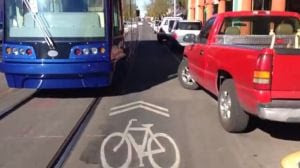(The following is from an email sent to Saint Paul Smart Trips and my City Council Representatives. I was asked to post it here.)

This is the lead photo from the email sent out by St. Paul Smart Trips encouraging me to support streetcars in St. Paul by attending a public meeting.
I was not able to attend the streetcar meeting but I am glad to hear that the proposal to study the streetcar concept got approval to move forward.
I am not against streetcars. All of my career I commuted by bike in the summer and Metro Transit bus in the winter. A streetcar would be much preferred to a bus. The above photo inspired me to search out more information on how streetcars and bicycles interact in other cities. In looking at the photos and links below it becomes clear that it takes really good design (and probably a lot of money) to integrate streetcars successfully into the existing infrastructure while providing safe travel for all. Also, it appears that most cities forge ahead, build the streetcar, and deal with the issues later. I am definitely against that approach.
I read through the streetcar posts on the Open Saint Paul forum and found that no one was mentioning bicycles so I thought I should comment.
This is what I found in looking around the net…



And Tucson isn’t the only city having problems.

This approach has been tried in Washington DC – to me it doesn’t look safe for either bikes or peds.
http://greatergreaterwashington.org/post/16675/there-are-many-strategies-for-mixing-bikes-streetcars/
Here’s another TV news story, this time from Toronto, subtitled “A new study says an inordinate number of bicycle accidents in Toronto are caused by streetcar tracks.”
http://www.cbc.ca/player/News/ID/2297244734/
